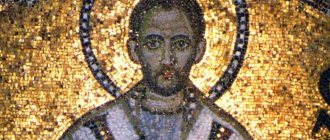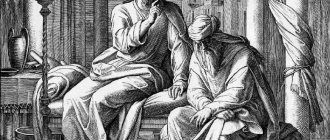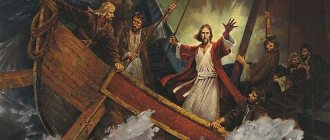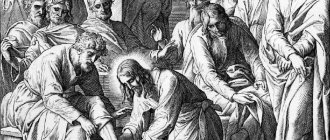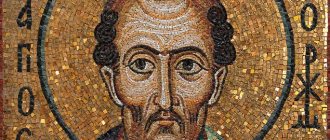The Gospel of John is one of four accounts of the Christian gospel included in the canon of Holy Scripture. It is known that none of these books had proven authorship, but it is traditionally believed that each Gospel was written by four disciples of Christ - the apostles. According to the testimony of Bishop Irenaeus of Lyons, a certain Polycrates, who personally knew John, claimed that he was the author of one of the versions of the “Good News.” The place of this Gospel in theological and theological thought is unique, because its text itself is not only and not so much a description of the life and commandments of Jesus Christ, but rather a statement of His conversations with his disciples. It is not without reason that many researchers believe that the narrative itself was formed under the influence of Gnosticism, and among the so-called heretical and unorthodox movements it was very popular.
"Origen's Masterpiece"
This is what the French researcher Henri Cruzel called the ancient theologian’s comments on the Gospel of John. In his work, Origen criticizes the Gnostic approach to the text, while quoting extensively from his opponent. This is an exegetical work in which the famous Greek theologian, on the one hand, opposes unorthodox interpretations, and on the other, he himself puts forward several theses, including those concerning the nature of Christ (for example, he believes that man should move from his own essence to the angelic one), which were later considered heretical. In particular, he also uses a version of the translation of John: 1.3, which was later recognized as inconvenient.
Purpose of writing.
Formulated at 20:31, it was to bring the “signs” revealed by Christ to the readers of the Gospel so that they would believe in Him. Undoubtedly, the author had other goals. So, some believe that John spoke out here against synagogue Judaism, others - that against the Gnostics or against the followers of John the Baptist.
It is believed that this Gospel was written to complement the other three. One way or another, there is no doubt that when writing this book, the Apostle John set himself an openly evangelistic task (just like other evangelists); and throughout its history the Church has widely used the book of the Apostle John for precisely this purpose.
When the Gospel Was Interpreted Politically
It may sound surprising, but the interpretation of Scripture has also been used to justify mass repression, the extermination of undesirables, and the hunting of people. This phenomenon was most clearly manifested in the history of the Roman Catholic Church. During the early days of the Inquisition, chapter 15 of the Gospel of John was used by theologians to justify the burning of heretics at the stake. If we read the lines of Scripture, they compare the Lord with a vine, and his disciples with branches. So, by studying the Gospel of John (chapter 15, verse 6), you can find words about what should be done with those who do not abide in the Lord. They are cut off, collected, and thrown into the fire, like branches. Medieval canon law lawyers managed to interpret this metaphor literally, thereby giving the go-ahead to cruel executions. Although the meaning of the Gospel of John completely contradicts this interpretation.
Medieval dissidents and their interpretation
During the reign of the Roman Catholic Church it was opposed
They were the so-called heretics. Modern secular historians believe that these were people whose views differed from the dogmas of the spiritual authorities “dictated from above.” Sometimes they were organized into communities, which also called themselves churches. The most formidable rivals of the Catholics in this regard were the Cathars. They not only had their own clergy and hierarchy, but also a theology. Their favorite Holy Scripture was the Gospel of John. They translated it into the national languages of those countries where the population supported them. The text has reached us in Occitan. In it, they adhered to the version of the translation of the Prologue, which was rejected by the official church, believing that this could justify the presence of a source of evil opposing God. In addition, when interpreting that very chapter 15, they emphasized keeping the commandments and living a holy life, and not on observing dogmas. Anyone who follows Christ is worthy to be called His friend - this is the conclusion they drew from the Gospel of John. The adventures of different interpretations of the text of Scripture are quite instructive and indicate that any interpretation of the Bible can be used both for the benefit of a person and for his harm.
Gospel of John
The Gospel of John (Ancient Greek: Εὐαγγέλιον κατὰ Ἰωάννην (Kata Iōannēn, lit. “according to John,” “according to John”), Latin: Evangelium secundum Ioannem) is the fourth book of the New Testament. According to Christian tradition, it is believed to have been written by the Apostle John, the “beloved disciple” of Jesus Christ, who was later called John the Evangelist.
Key to the Gospel
The key to John's Gospel is found in 1 John 1:1-3:
1 About what was from the beginning, what we have heard, what we have seen with our eyes, what we have looked at and handled with our hands, about the Word of life - 2 for the life has appeared, and we have seen and testify, and proclaim to you this eternal life, which was with the Father and appeared to us, - 3 what we have seen and heard we declare to you , so that you also may have fellowship with us: and our fellowship is with the Father and His Son, Jesus Christ. (1John 1:1-3)
Only the tangibility of the eternal makes it possible to preach the gospel about it; without this tangibility, the eternal would remain unknown to us. Thus, the Gospel of John reveals to us the final mystery: penetrating into it through the perception of the tangible, we thereby become familiar with the incomprehensible!
Author's name
The author's name, John, appears in the title of the fourth Gospel. The author himself calls himself “the disciple whom Jesus loved” (John 13:23; 19:26; 21:20,24); many details indicate that he belonged to the inner circle of the Lord.
- He knew the traditions and customs of the country well (John 2:6; 3:25; 11:44,55; 19:31,40)
- he knew the calendar of Jewish holidays (John 2:13; 6:4; 7:2; 10:22)
- details in the description of certain places indicate that the author personally visited them (John 3:23; 4:11; 5:2; 9:7)
- he was "known to the high priest" (John 18:15)
- the author remembers many details related to Jesus, for example, at what time of day certain events took place (John 1:39; 4:6; 19:14)
- he keeps in memory the words of the disciples (John 6:7-9; 11:16; 14:5,8,22).
At the Last Supper he reclined “at the breast of Jesus” (John 13:23).
Of the three disciples who were closest to Jesus (Peter, James, John; Matthew 26:37), the first, James, was martyred early (44 AD; Acts 12:2), and the second, Peter - cannot be this unnamed disciple, because he is mentioned with him (John 18:15,16; 21:20).
Not only the title, but also the content of the fourth Gospel points to the Apostle John as its author.
Time of writing and addressee
1 According to the testimony of Irenaeus of Lyons, a disciple of Polycarp of Smyrna, who was, in turn, a disciple of John, the apostle wrote his Gospel while he lived in Ephesus.
In accordance with this evidence, the Gospel of John is still considered a late work of the apostle and dates back to the end of the 1st century AD.
Related article: Gospel of John. Lessons
The distinctive features of this Gospel - the figurative language, the richness of oppositions (for example, light and darkness) - were previously attributed to Hellenistic influence. But the study of the Dead Sea Scrolls showed that the corresponding style and style of presentation were characteristic of Jewish literature even in the time of Jesus.
From this we can assume that, like the other three Gospels, the Gospel of John was written before 70 AD.
2 Unlike the other Gospels, which are addressed primarily to non-believers, the Gospel of John is addressed directly to the Church. In it, the image of the Lord is presented as Jesus revealed Himself to a close circle of disciples - full of greatness and glory.
Speaking about this difference in the gospel addressed to the world and the Church, it should be noted that along with the first principles of teaching, the New Testament epistles also set forth wisdom intended for the perfect (Heb. 5:11 - 6:2; cf. 1 Pet. 2:2), and example This division was given by Jesus Himself (see also Mark 4:10-20,33,34).
Composition
The composition of the Gospel of John contains 21 chapters. The prologue defines the theme (John 1:14) and names two key concepts that could become headings for the two main sections of the Gospel of John (vv. 5,17).
A similar division is inherent in the book itself, which speaks of light and darkness right up to John 12:46.
Prologue: The Word became flesh and dwelt among us (1:1-18).
A. Light and Darkness (1:19 - 11:57):
- the light shines in the darkness (1:19 - 4:54):
- the appearance of light (1:19-51);
- light in Israel (2:1 - 3:36);
- light to the lost sheep (4:1-54);
- the darkness did not overcome the light (5:1 - 11:57):
- the approach of darkness (5:1 - 6:15);
- the distinction between light and darkness (6:16-71);
- the struggle between light and darkness (7:1 - 11:57).
B. He came to his own, and his own did not receive Him (12:1 - 21:23):
- He comes to his own (12:1 - 17:26):
- the meeting of the Lord with his own (12:1 - 13:38);
- the promise of peace for the Church (14:1 - 17:26);
- His own do not accept Him (18:1 - 19:42):
- in human hands (18:1-40);
- exile (19:1-42);
- those who received Him (20:1 - 21:23):
- acceptance of the Risen One 20:1-31);
- the last meeting on earth (21:1-23).
Contents of the Gospel
John 1:1 In the beginning was the Word, and the Word was with God, and the Word was God
Glory
1) even if the secret will forever remain secret to us, we can still comprehend the tangible. The leitmotif here is glory, honor and authority [Greek. doxa ]. Recognition of the superiority of the owner of this quality over other people makes the latter bow before Him.
Jesus Christ possessed such glory before the world was (John 17:5). Everything that exists in the world has its beginning in Him and is thus in absolute dependence on Him (John 1:3).
This glory cannot be achieved independently, it is bestowed only by God Himself (John 17:22) and represents the highest degree of unity of the Glorified One with the Glorifying One (John 10:30).
The glory of Christ is the glory of eternity. Therefore, only in a hidden form can this glory penetrate into a world mired in sin, in which Christ must glorify the Name of His Father (John 12:28), i.e. to reveal Him in all His glory, leading people to recognize God.
Thus a miracle happened: the Word became flesh, the eternal God became tangible to people, and the Lord of all things (Matthew 11:27) took on the role of a servant (Matthew 20:28).
God's glory, which is also the glory of Christ, is revealed in His power over all things in this world, the nature of which He transforms (John 2:11), and also in His power over death, which He has conquered (John 11:40).
The Gospel of John tells of some of the miracles performed by Jesus (John 21:25). Christ does not perform miracles so that people can gain faith through them (Matthew 12:38,39; 1 Cor 1:22), because the admiration caused by miracles could, rather, prevent the gospel from achieving its main goal - to reveal to us God's essence, His love (1 John 4:16).
Love
2) God demonstrated this love by sacrificing His only begotten Son, through which He was called to save a lost world and give people eternal life (John 3:16,17). But God's work in Christ bears fruit only if the sacrifice made is accepted.
Thus, God's love is revealed to us in Jesus' desire to win human souls. Therefore, the Gospel of John tells in detail about the Lord’s caring conversations with the soul (John 3; 4; 13-16; 18:28 - 19:16; 21).
Disciples are called to preach God's love to the world. They were given the commandment to love one another so that the world would recognize them as disciples of Jesus Christ (John 13:34,35). The sonship of Jesus is the reason why the Father's love for Christ is also present in His disciples (John 17:26).
This is active love: it gives strength to sacrifice oneself, to die for the sake of friends (John 15:13). Love does not serve for a person to glorify himself.
The disciples' love for Christ, like Christ's love for the Father, is manifested in obedience (John 14:15,23,24), glorifying the Lord by imitation of His saving love (John 4:34; 6:38; 20:21).
Birth
3) entering the Kingdom of God is possible only through a new birth (Rebirth) from God (John 3:5), through the acceptance by faith of the testimony of Christ.
Related article: Renaissance
The one who is born again participates in the eternal life revealed in Christ (John 1:12; 5:24). Man, who until now lived in darkness and a spiritual vacuum, now lives in God's light and communion with God (John 3:19-21; 6:56; 12:46; 15:4-7).
This is the only way to find peace that overcomes the fear that reigns in the world (John 16:33).
The basis of the saving work of Christ is the liberation of man from the power of the devil, in which man found himself as a result of his sins (1 John 3:8). Sin begins with lies, the father of which is the devil (John 8:44). Man must be redeemed from the slavery of sin so that he can enter the world of Divine truth. This is what Christ did, who, as the Lamb of God, bore the sins of the world (John 1:29).
The new world is presented in the Gospel of John as a world of truth. The glory of Christ is full of grace and truth (John 1:14); Being Himself the truth (John 14:6), He testifies to it (John 18:37).
Related article: Truth Today Magazine
In Jesus lies the truth that makes possible true worship of the Father (John 4:23,24) and true obedience to the voice of the Son (John 18:37). Through knowledge and acceptance of the truth, a person gains freedom (John 8:32), perceives the Spirit of truth (John 16:13), and the Word of God becomes saving truth for him (John 17:17).
Evangelism
4) The essence of the gospel of the Gospel of John is presented in a short prologue to the book (John 1:1-18). John, unlike, for example, Luke, does not describe the life of Jesus before the beginning of His public ministry: the Gospel of John immediately immerses us in the radiance of the glory of Christ. The author used this technique deliberately.
The gospel of Christ can be one-sided, portraying Jesus only as the Son of Man. Thus, His true purpose is distorted, since the gospel is designed to bring a person closer to God and help ensure that the ascended Christ is “figured” in the hearers (Gal. 4:19).
This is why the Gospel of John reveals the glory of Christ, who desires to abide in us and in whom we must abide (John 15:4).
Human
5) such a depiction of the glory of Christ was not accepted by those who wanted to present Jesus as only a man. Already in the 2nd century. according to R.H. there was a concept according to which the Lord was a man who acquired divine essence only at baptism.
Attempts have also been made to detect foreign influences in the prologue of John's Gospel, with commentators primarily pointing to the concept of logos ("word"), which played a significant role in Greek philosophy and, above all, in the Judeo-Hellenistic philosophy of Philo of Alexandria.
The apostles used for their preaching the language in which people of their time communicated, but they filled familiar words with new content. This is evidenced by a comparative analysis of the New Testament works and the works of ancient philosophers.
The living Word of God, through which “all things came into being” (John 1:3,4), has nothing in common with the philosophical concept of “logos”. How different these two concepts are becomes clear from the Gospel of John itself, in particular from the story of Jesus’ interrogation by Pilate (John 18:33-38), where the procurator cannot understand what truth Jesus is telling him.
